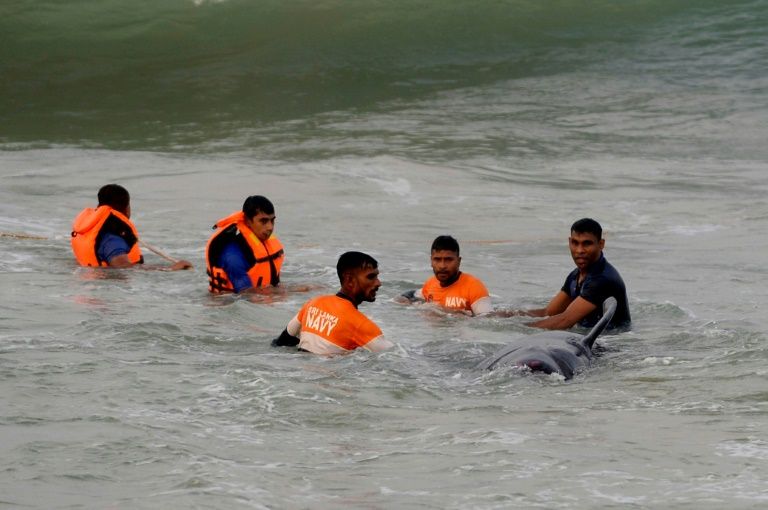Sri Lanka rescues 120 whales after country’s largest stranding
A handful of whales had started beaching in the early afternoon and their numbers swelled to more than 100 by dusk, overwhelming local volunteers, resident Pathum Hirushan told AFP.
“Some of the fishermen from the area tried to push back the whales. The sea was rough and the waves would bring them back to shore,” Hirushan said.
“It was very tiring, but later the navy came in with their boats and worked through the night.”
The navy and the coastguard, as well as dozen of volunteers, were able to move the other mammals into deeper waters with the aid of small patrol craft by dawn on Tuesday, navy spokesman Indika de Silva told AFP.
Volunteers had come forward to help with the rescue despite the region being under a days-long lockdown to combat the spread of the coronavirus pandemic.
Pilot whales — which can grow up to six metres (20 feet) long and weigh a tonne — are highly social.
The causes of mass strandings remain unknown despite scientists studying the phenomenon for decades.
The wildlife department’s chief veterinarian Tharaka Prasad told AFP autopsies were carried out on the dead whales and officials were “satisfied they were disoriented”.
He hailed the rescue as one of the most successful in the world.
Authorities had braced for mass deaths, after some 360 out of 470 pilot whales that beached in a remote harbour in Australia’s southern island state of Tasmania in September were not able to be saved.
Sri Lanka’s Marine Environment Protection Authority had said Monday that the Panadura stranding was the South Asian country’s largest.
The last mass beaching in Sri Lanka was in June 2017 when 20 pilot whales were stranded at a beach in the coastal town of Sampur near Trincomalee harbour in the country’s northeast. All were saved.
A sperm whale was stranded inside Trincomalee harbour in April 2011 and two navy boats guided it out into deeper waters where it was reunited with waiting whales.
The waters around Trincomalee, used by Allied forces as a staging post during World War II, have a high concentration of blue and sperm whales.
Disclaimer: Validity of the above story is for 7 Days from original date of publishing. Source: AFP.


